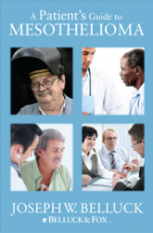Mesothelioma Diagnosis: Medical Thoracoscopy
A medical thoracoscopy is a diagnostic procedure that allows doctors to perform an internal inspection of the structures in the pleural cavity. The inspection is performed by the insertion of a thorascope — a narrow tube with a light and a microchip camera attached — through a small incision in the chest wall. The procedure is also known as a pleuroscopy.
Medical thoracoscopy is a diagnostic procedure that should be distinguished from another kind of thoracoscopy that is known as surgical thoracoscopy, or more commonly, video-assisted thoracic surgery (VATS). VATS is an advanced surgical technique that involves both diagnostic and surgical procedures. Medical thoracoscopy and VATS are sometimes used interchangeably, but the operative scope of the latter procedure is wider than the scope of the former.
For the remainder of this article, we will refer to medical thoracoscopy simply as thoracoscopy.
Purpose
A thoracoscopy is often performed on patients who may have lung cancer or malignant mesothelioma. The thoracoscopy allows surgeons to examine the lungs and other structures inside the chest without having to make the large incision required during a thoracotomy, a highly invasive procedure that involves significant tissue resection and separating part of the rib cage to expose the lungs. During a thoracoscopy, doctors can make an assessment of the lungs and pleural cavity, take a biopsy, administer medication directly to the affected area and even drain fluids that may have accumulated around the lung. When used in these latter ways, the procedure has a therapeutic component to it but is still considered a mainly diagnostic procedure.
Thoracoscopy and Mesothelioma Diagnosis
When diagnosing mesothelioma, doctors typically utilize several different testing procedures — from physical examinations to pathology tests. A thoracoscopy may be performed when a doctor suspects pleural mesothelioma. The procedure allows doctors to find tumors in the pleural cavity or lungs and take tissue samples, or biopsies, without having to perform an open chest procedure. While a thoracoscopy is still invasive, it reduces the amount of surgery needed, the pain involved, the length of the hospital stay, and the patient’s recovery time.
Preparation
Before a thoracoscopy is performed, patients must undergo a series of routine tests, including a blood test, a urine test and chest x-rays. The x-rays allow doctors to determine where to make the incisions. Older patients may also have to undergo an electrocardiogram because the combination of anesthesia and lung deflation may place an increased strain on the heart. Patients should not eat or drink after midnight on the night before surgery. Doctors should be notified of any and all allergies and medications being used.
Procedure
The thoracoscopy procedure begins with two or three small incisions in the chest wall. Surgeons choose an area that allows them the best angle to work on the suspected area while avoiding any areas that come close to the heart or spine. One incision is used for the insertion of the endoscope, which allows the doctors to see a video broadcast of the lungs and affected areas on a TV monitor. The other incisions are used for the insertion of diagnostic tools.
During a thoracoscopy, a lung is deflated and the patientss breathing is assisted by a ventilator, a mechanical device which helps the patient to inhale and exhale. The lung is deflated to allow the surgeon space to work between the chest wall and lung. The procedure general takes two to four hours.
During the procedure, the doctor may take tissue samples from the lung. These samples will then be sent to a lab for testing to determine the cause of any tumor or inflammation. Doctors may also take samples from any fluids that may be collecting around the lungs.
The lung is re-inflated after the procedure. A tube is left in one of the incisions to allow drainage of fluids and air.
Risks
The risks of thoracoscopy include bleeding, infection, air leaks through the lung wall and lung inflammation, although great care is taken to prevent any of these side effects.
After Care
Patients typically remain in the hospital for one or more days after the procedure so they can be monitored and to allow for the drainage of air and fluids.
After being released from the hospital, patients should avoid heavy lifting and yard work. Patients can ease into activities slowly over a period of several weeks. Breathing may be uncomfortable at first and patients should rest when tired. Walking is very important because it increases circulation, builds up strength, and increases lung capacity.
Patients who experience negative symptoms should contact their doctor immediately. Some common problems include: sudden, severe shortness of breath or chest pain; high fever; rapid heartbeat; and drainage or very red incisions.


